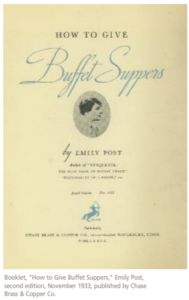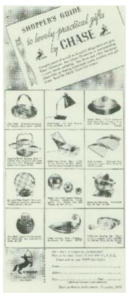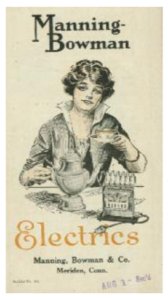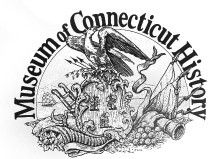By David Corrigan, first published in Connecticut Explored Magazine.
In September 1933, in the midst of the Great Depression, the Chase Brass & Copper Co. of Waterbury signaled its entrance into the electrical appliance business with its sleek, shiny, streamlined chromium buffet server. It was a radical departure for a staid old Connecticut firm, founded in 1876, that specialized in the manufacture of brass wire, tubing, and sheet metal, most likely prompted by a need to diversify in a depressed economy that required fewer of its traditional products for the construction and plumbing trades.
By the 1930s, the Chase name was well known and well respected. As a result of several mergers and acquisitions, the company had established manufacturing and distribution facilities around the country, so it was also well positioned to mount a nation-wide marketing program for its new product.
Buffet-style lunches and dinners had become popular in America in the early 1900s, and by the 1930s less formal, more casual entertaining was widely accepted. Rodney Chase, a thirdgeneration Chase Brass executive who was the company’s assistant secretary and advertising manager, seems to have astutely grasped the new economic and social realities and recognized the company’s opportunity. Chase Brass hired Lurelle Guild, a prominent New York industrial designer, to design a new appliance that would embody the buffet-dining trend. Chase also hired Emily Post, the most prominent spokesperson for etiquette and proper social behavior, known to millions through her books and radio program, to write a booklet called “How to Give Buffet Suppers” that was intended to help create a market for the new appliance. Each purchaser of a Chase buffet server received a copy of Post’s booklet, which stressed the social and economic value of buffet suppers, extolled the virtues of the buffet server, and included numerous recipes that she considered especially well-suited to the new appliance. Post’s booklet was also available for purchase from the company. In addition, Chase launched an aggressive advertising campaign to promote the new appliance, placing advertisements in such publications as House Beautiful, The American Home, and Good Housekeeping.

In hiring Lurelle Guild and Emily Post and mounting a comprehensive advertising campaign to promote its buffet server, Chase Brass exemplified the old, established Connecticut manufacturing company seeking to move into the mainstream of 20th-century product design, manufacturing, and promotion. But 1933 was not the most opportune time to launch a new product. The consumer spending spree of the 1920s had run its course, and unemployment in America was at an all-time high of nearly 26 percent. Yet the Roosevelt Administration urged Americans to open their wallets and begin buying again to stimulate the economy.
While many Americans suffered extreme hardship in the early 1930s, a sizeable portion of the population still had disposable income—less, perhaps, than before 1929, but still more than many of their contemporaries. As Edward A. Ryerson, chairman of the board of the Inland Steel Company of Chicago, noted, “Until the late 1920s, everything was going pretty well with us. The Depression hit us like everyone else…. Most of my friends, who represented wealth, were all in some way affected…. Most I knew suffered setbacks. We’d have to readjust our way of living. We all did. We did more for ourselves. I did away with my chauffeur and so forth. I drove my own car, my wife did and all that sort of thing.”
In 1929 Chase had introduced a line of lowand moderately-priced giftware and specialty items such as ashtrays, napkin holders, vases, and nut dishes, all of which had broad public appeal. But the company’s marketing campaign for the buffet server represents a well-considered business decision to appeal to consumers such as the Ryersons who, after doing away with chauffeurs and reducing the number of domestic servants they employed, were still able and eager to maintain a fairly high standard of living. A Chase buffet server allowed them still to entertain well, without the bother of formal, sit-down dinners—and with the important imprimatur of Emily Post. The language of Emily Post’s endorsement of the buffet server and the advertising copy describing it confirms this appeal to a certain level of affluence and social standing that were unattainable to the vast majority of American consumers in 1933.
FROM FOOD WARMER TO BUFFET SERVER
On October 31, 1933, Lurelle Guild received a design patent for “a new, original, and ornamental Design for a Food Warmer.” Under contract to Chase Brass, Guild assigned the patent to the company, later receiving a royalty on each appliance manufactured. The server featured a chromium base to be half-filled with water and an electric heating element that warmed the water to between 160 and 180 degrees. Guild’s innovative design had four covered, white-porcelain casserole dishes set into the base; the food they held would be kept hot by the water in the base.

Advertisement, “Shopper’s Guide to lovely-practical gifts by Chase,”
Better Homes and Gardens, November 1936 Museum of Connecticut History
Since electrical service in the United States had not been completely standardized by 1933, the buffet server could operate on either A.C. or D.C. current, on a 110- to 120-volt circuit, and at 25, 40, or 60 cycles. Furthermore, before the rural electrification program began in 1935, electrical service was primarily available to city-dwellers. Luckily for Chase, the majority of Americans had, since the 1920s, become city-dwellers who were, in turn, the main people buying electrical appliances. Although Guild’s design patent for a “food warmer” was granted in October, he had applied for his patent in August, and Chase announced its new “buffet server” in September. Guild’s assignment of his patent to Chase Brass was a mere formality, since Rodney Chase had probably commissioned the design months earlier with an eye to promoting the product as a more upscale “buffet server.”
EARLY 20TH-CENTURY INDUSTRIAL DESIGN
Chase Brass’s hiring of Lurelle Guild to design its buffet server reflects the company’s commitment to industrial design and industrial designers, who had became familiar elements of American manufacturing during the 1930s. Industrial design was understood as an approach to designing machine-made, mass-produced goods that captured the era’s fascination with technological progress and speed, as best expressed in the aerodynamic design of the airplane. According to historian Jeffrey Meikle, the streamlined style developed by the designers “…employed sweeping horizontal lines, rounded corners, and shells intended to shroud projections that might detract from an image of effortless, frictionless motion.”
The metal chromium played a major role in streamlined design. Applied to a base such as sheet brass using an electroplating process, chromium provided a strong, lustrous finish, resistant to tarnish and corrosion. The smooth, reflective surface added to the illusion of speed and movement sought by designers, making chromium items both beautiful and functional.
Industrial designers came to manufacturing from a variety of backgrounds, including commercial art, graphic design, stage design, and advertising. They were, however, united in the belief that mass-produced items were amenable to good, modern design and that consumers were ready to discard earlier, less attractive products that were often poorly designed by product engineers with no artistic training. Leslie M. Bingham, commercial secretary of the Manufacturers’ Association of Connecticut and editor of its monthly publication Connecticut Industry, described a not uncommon situation when he noted that, in the 1920s, “Heads of companies, production managers and salesmen conferred from time to time and products that were a composite of what the public might like, what the Vice President’s wife thought was pretty and what the factory superintendent said was possible, were brought to market.”
Industrial designers brought to manufacturing a new design aesthetic, combined with an understanding of industrial processes. Since many manufacturers in the 1930s thought that under-consumption was the root cause of the depressed economy, they readily agreed to the designers’ proposals to re-design existing products and create new products in the streamlined style to stimulate consumption and restore a healthy economy.

Trade catalog for Manning, Bowman & Co., Meriden, competitor of Chase Brass, c.1925 Museum of Connecticut History
DESIGNER LURELLE GUILD
Lurelle Guild (1898-1985) was born in Syracuse, New York and graduated from Syracuse University in 1920 with a degree in painting. With his wife, Louise, he soon established his own firm in New York City, Lurelle Guild Associates. They later purchased a home in Darien, and Guild worked out of a studio there. He wrote many articles for women’s magazines, designed covers for architectural and decorating magazines, bought and sold antiques, designed and marketed home furnishings, and pursued an interest in early American crafts. His industrial design work began around 1927.
According to a 1934 Fortune magazine profile of industrial designers, Guild undertook a study of New Haven clockmaker Chauncey Jerome’s methods of mass-producing stamped, interchangeable brass clock parts. He had a complete knowledge of mechanical drawing and fully understood the processes of machine manufacturing. As a result, he could “…deliver drawings from which plant engineers can work directly.” According to the magazine, Guild redesigned “…about a thousand products a year” and never designed “…a product that was a commercial failure, has never lost a client.”
Guild designed many items for Chase, including a complete line of electric lamps and lighting fixtures in the late 1930s. In addition to his work for Chase in the 1930s, Guild also worked for about two dozen other Connecticut companies during his career, including the General Electric Company in Bridgeport, the A.C. Gilbert Co. in New Haven, International Silver Company in Meriden, The New Haven Clock and Watch Co., and the Fitzgerald Mfg. Company of Torrington. He is perhaps most widely known for his streamlined design of an electric vacuum cleaner for the Electrolux Corporation, headquartered in Old Greenwich, in 1937. He also designed the famous “Kensington” line of tableware for the Aluminum Company of America.
EMILY POST ENDORSES THE BUFFET SUPPER
Emily Post (1873-1960) was born into a wealthy Baltimore family that later moved to New York, where she attended finishing school, was presented to society as a debutante, and married a prominent New York banker in 1892. The couple had two sons, but the marriage ended in divorce in 1905 as a consequence of her husband’s repeated infidelities. To support herself and her sons, Post turned to writing shortstories and novels, achieving a fair amount of success. Given her social background and demonstrated writing ability, an editor at Funk & Wagnalls suggested she write a book on etiquette.
Obviously well-suited to the task, Post wrote Etiquette in Society, in Business, in Politics, and at Home, published in 1922. An instantsuccess, Etiquette can be interpreted as a how-to guide for the nouveau riche of the early 1920s, who sought entrance into society by learning proper ways of behaving, speaking, and entertaining. The second edition of Etiquette appeared in 1927, and Post, recognizing changing social conditions (especially the declining numbers of domestic servants), introduced a figure she labeled “Mrs. Three-inOne,” the woman of the house who served as cook, waitress, and hostess and ran her household without benefit of servants.
In 1933, Post wrote the 24-page booklet “How to Give Buffet Suppers” for Chase Brass. Although the actual number of buffet servers manufactured is unknown, one indication of the item’s popularity is the fact that Post’s booklet was in its fourth edition by April 1934. Post noted that “…every variety of buffet party would seem to be at least one happy result of the depression” and that “The well-known depression gave us one thing anyway—the buffet supper.” She then went on to suggest buffet suppers for the golf foursome after their game, for the bridge party, and after attending the football game. Though it did feature Mrs. Three-In-One, the booklet focused on hostesses who still had servants and large, roomy homes in various historical revival styles, and enough plates, cups, and saucers, knives, forks, and spoons to furnish a large buffet table.
The booklet’s center spread shows a buffet table set for 16, with the Chase buffet server prominently displayed. The caption reads, “Arranged by Mrs. Emily Post in her little old New England house,” which was located in Edgartown on Martha’s Vineyard, a locale that by the 1930s had evolved into an exclusive enclave for wealthy New York City residents.
Post then made her sales pitch, couched in terms of affluence. “There is now a very last word in buffet equipment—the debutante daughter, as it were, of the chef’s bain marie, or a four compartment chafing dish. Its designer has called it a ‘buffet server.’ But no matter what it is called, it is quite the most delectable novelty that has been produced; to me at least, it is completely tempting.” Post’s claim that Guild had patented a “buffet server” was fully in keeping with Chase’s promotion of its new product. In fact, by the time Guild received his patent, Rodney Chase had already re-branded his prosaic “food warmer” as the more elegant “buffet server.” Further elaborating, Post asserted that the buffet supper had permanently replaced the formal, sit-down dinner, and even if the New Deal brought about a return to prosperity, the current trend toward informality would remain. Post was convinced that “all the men of the smart world”—that highly fashionable, elegant element of society—would never again “appear in tail coats or formal wear every evening in the week…” for a formal sit-down dinner.
ADVERTISING THE BUFFET SERVER
The tenor of Post’s observations was echoed in Chase’s advertisements for the buffet server. A typical advertisement, “Breakfast Buffet or Cooks Made Happy on Sunday Mornings,” from House Beautiful of April 1934, promises that, with a Chase buffet server, consumers could “Have a breakfast buffet next Sunday morning. Then you can get up any old time and find a hot meal waiting for you. All cook has to do is to prepare things, place them in the Chase Electric Buffet Server…and she is free for the rest of the morning to go about the serious business of preparing dinner.” This advertisement is obviously directed to those Depression-era families still affluent enough to have a cook tasked with preparing both a buffet breakfast for late-rising family members and guests and able to spend several hours preparing the family’s dinner.
In a June 1934 advertisement Chase suggested the gift of a chromium buffet server for a new bride, arguing that, unlike silver or silver plate, the buffet server, with its hard, corrosionand tarnish-resistant surface, would never need polishing. By the early 1930s,sales ofsilver and silver plate items dramatically declined, as had the availability of servants to polish them. But, while the suggestion to replace a wedding gift of silver with chromium fit within the budgets of many of the formerly wealthy, the $40 price of the buffet server in 1934, and its price of $45 a year later, still placed Emily Post’s “most delectable novelty” beyond the means of most American wage earners, many of whom were hard-pressed to supply their families with the bare necessities and often wondered where their next meal was coming from.
BACK TO BRASS
Although Emily Post admitted that she never cooked a meal herself and once confessed that if forced to provide for herself she’d have to live on bread and water, her endorsement of the Chase buffet server testifies to her influence on social behavior and its manifestation in the dining rooms of a certain stratum of American society in the 1930s. In contrast to Manning Bowman of Meriden and Landers, Frary & Clark of New Britain, who manufactured complete lines of moderately priced electric appliances from the early 1900s to the 1950s, Chase Brass & Copper for a short time offered its buffet server at the upper end of the price range, thereby limiting its market to consumers who’d been least affected by the economics of the Depression. By 1941, Chase had ceased production of its gift, specialty, and appliance lines. Although the company promised to resume production after the war, streamlined design had fallen out of favor by the mid-1940s, and Chase reverted to its role as a major supplier of industrial brass and copper products. The company’s well-designed buffet server survives as a highly sought-after example of a high-end, streamlined electrical appliance that briefly graced the dining rooms of the fairly-well-to-do and formerly wealthy Americans of the 1930s.
